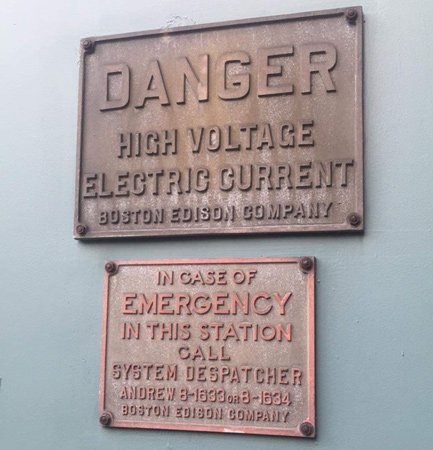Once, all Bostonians could tell you how many cookies Andrew ate

Roving UHub photographer Greta Gaffin (yes, the former UHub copy desk) spotted these signs today in the back of the BU College of Arts and Sciences. Boston Edison and "despatcher" alone are enough to date them, but also notice one of the phone numbers: Andrew 8-1633.
It's from the days when local phone numbers all started with two letters - which stood for a longer name, back when phones had rotary dials and each number (save 0 and 1) had three letters associated with them. Today, you'd just dial 268-1633 (well, and you'd have to add the area code, too).
Back in the day, the Andrew exchange, which covered South Boston, was particularly known for radio ads by Adams and Swett, a carpet-cleaning company that got an Andrew 8 number when it moved from Kemble Street in Roxbury to 380 Dorchester Ave. in 1957.
How many cookies did Andrew eat?
Andrew ate 8000.
How do you keep your carpets neat?
Call Andrew 8-8000.
The company, founded in 1856, exists to this day, now in Quincy. And it still has the same number, although now it goes by the more boring version of 617-268-8000.
Boston Edison, of course, gave way to NStar and then Eversource.
Ad:

Comments
Showing my age...
...and my native Bostonian-ness, but I can hear that "how many cookies did Andrew eat" song in my mind to this day. :-) :-)
Judy Valentine
Judy Valentine sang that jingle
Is this commercial online anywhere?
and if it is, can you link to it?
Surprisingly no it is not.
Surprisingly no it is not. This was a radio jingle though so it wouldn't have any video to post. I'm an Old Time Radio fan and I've never run across it while listening to old shows.
There were TV commercials also
And while the jingle played they included a few seconds of a cartoon image of a kid eating cookies from a cookie jar.
"Come on Down"
"Come on Down"
"The Meat Falls Off the Bone"
"Anthony, Anthony"
"A Whale of a Good Time"
"You'll love it at levitz"
"Quality, comfort and Price, that's nice!"
Why Andrew 8- and not Andrew 3-?
All the other exchanges that I recall had that 1st digit correspond to the number for the 3rd letter of the exchange name: CApital 7, DEcatur 3, BIgelow 4, and especially KLondike 5-. (The latter, of course, being the exchange in every movie or TV show, because no exchanges used 5/JKL.)
So why the special exemption for Andrew?
That's how they started
which allowed old 6-digit phone numbers to transition easily into the new 7-digit world. So ANdrew 1234 beame ANdrew 3-1234. This allowed the phone company to add more numbers at ANdrew 4, ANdrew 8, etc.
South Boston was an exception...
New England Telephone (a wholly-owned subsidiary of AT&T) introduced 3-letter, 4-digit dialing in the 1920s: COPley 1234, COMmonwealth 5678, and so on. Around 1947, they converted to 2-letter, 5-digit: COpley 7-1234; COmmonwealth 6-5678;.... Somewhere I have a photocopy of a brochure from NET&T back in the 1940s, that describes the changes in detail. Unfortunately, the last time I saw that copy was 3 moves and 20 years ago, so it isn't easy for me to find it right now. But I do basically recall what it said.
The announced (publicized) reason at the time was for expansion. As noted by someone else, if you only used two letters to form a word, the third character of the exchange could be any digit from 2 through 9. (Eventually they also used 0 and 1.) That allowed Cambridge, for example, to have both UNiversity 4 and UNiversity 8.
Another, less publicized reason for making that 1940s change was probably to standardize phone numbers on a nationwide basis, to allow for direct distance dialing -- still in the future at the time, but they were starting to plan for it.
But -- there were a few exceptions in that 1940s switchover, and there were also other changes in the 1950s. And one of them was South Boston. Prior to 1947, South Boston phone numbers were SOUth Boston, or 768, and CITy Point, or 248. For some reason those got changed during the 1950s to ANdrew 8, or 268, and ANdrew 9, or 269, which is still what they are today.
Other 1947-era changes:
AVEnue [283] in Dorchester > AVenue 2 [282]
JAMaica [528] in Jamaica Plain > JAmaica 2 [522]
ARNold [276] in Jamaica Plain > JAmaica 4 [524]
HIGhlands [444] in Roxbury > HIghlands 5 [445]
RUGgles [784] in Roxbury > HIghlands 2 [442]
Later, in the '50s/early '60s, Arlington changed from ARlington to MIssion; East Boston from EAst Boston to LOgan, Hyde Park from HYde Park to EMpire, and others.
By the time I arrived in Boston as a college freshman in 1968, there were already some all-digit numbers such as 491- in Cambridge; but the phone directory still printed the letters for the older exchanges.
So the Cambridge 49-
So the Cambridge 49- exchanges never had a word?
Please Don't Be Frightened By The Graphics
Someone 27 years ago codified the exchanges.
http://www.verycomputer.com/28_270bcb9ab7688e60_1.htm
Salem was the PIoneer
The original two phone exchanges in Salem, are 744 and 745. More have been added since then.
My grandfather's old rotary phone had a label that had PIoneer 4-xxxx printed on it (xxxx = last four digits of phone number).
Salem has PIoneer, likely from Alexander Graham Bell having made the first public telephone call from the Lyceum Hall on Church Street. The plaque commemorating this event is still on the building today.